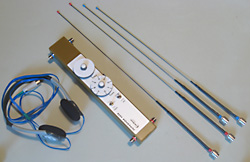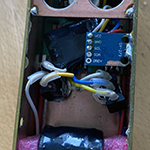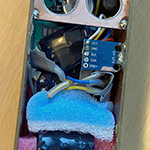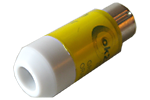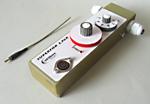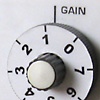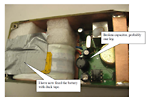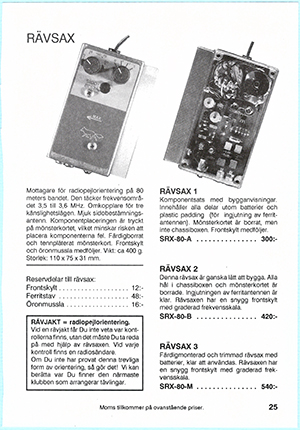August 2010
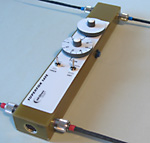 The current 144 MHz receiver failed occasionally by refusing to receive anything. But it worked most of the times. This was not acceptable when travelling abroad for larger ARDF competitions, so Hans ordered the improved version now called 145E. The option "electronic compass" was also fitted.
The current 144 MHz receiver failed occasionally by refusing to receive anything. But it worked most of the times. This was not acceptable when travelling abroad for larger ARDF competitions, so Hans ordered the improved version now called 145E. The option "electronic compass" was also fitted.
Good
- Very good sensitivity and forward/back characteristics
- Rigid and overall well designed.
Bad
- Non-standard DIN socket for headphones (which actually is a nice design also).
- No schematics, but that is really no problem, since supplier fixes any guarantee problems.
2013 August: Two new sets of antenna elements
When running in the forest Hans occassionally stumbles and falls to the ground. When this happens, the antenna elements are sometimes bent. Hans bought extra spares already in 2010, but they have now been destroyed. Hans orders 2 new sets of spare antenna elements. Price: 16 Euro per set of 4 elements.
2021-08-23: Repairing ANT and TIMER switches
When Hans used the receiver during the competition he organized 2021-08-09, he discovered that both switches on the front were broken.
Today, he picks up his soldering iron and override the ANT-switch to the wide-position by connecting two wires. Thre faulty TIMER-switch is left faulty since it is in the neutral position where no timing signals are generated. He also fixes the battery by inserting foam.
In the evening there is a 144 MHz competition and Hans can confirm that all works well.
Technical data
- Green light: Good.
Receiver is ready for competition. Charging is not necessary. - Yellow light: Enough for one race only. Receiver is ready for one training or race. Charging is recommended.
- Red light: Bad.
Charge the accumulator immediately. If this does not help, replace the accumulator. - 45×17 mm, 10 g
Documents
August 2010
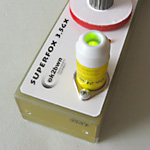 The T810 tester is a microprocessor controlled device designed for accumulator status check of ARDF receivers of type COMPACT and SUPERFOX. It tests the accumulator in the receiver under load.
The T810 tester is a microprocessor controlled device designed for accumulator status check of ARDF receivers of type COMPACT and SUPERFOX. It tests the accumulator in the receiver under load.
Just plug it in to the DIN-socket. Actually, this is one benefit with the DIN-socket; it gives access to both audio and battery poles, as well as it is used for the on/off switch.
Good
- Very easy to use
- Clear indication.
Bad
- None.
- None.
Xxxx 20xx
Xxxxxxxxxxxxxx
Good
- Very good sensitivity and forward/back characteristics
- Rigid and overall well designed.
Bad
- Non-standard DIN socket for headphones (which actually is a nice design also).
- No schematics, but that is really no problem, since supplier fixes any guarantee problems.
Technical data
- Double conversion superheterodyne
- Frequency: 3.48 to 3.71 MHz
- Antenna: Ferrite
- Damping: 120 dB in 8 steps
- Battery: NiMH accumulator 7.2 V, 320 mAh
- 100 x 180 x 30 mm, 350 g
July 20xx and August 2010
Hans has been running with the Saltsjö Data receiver since 1989. This direct conversion receiver has a low sensitivity resulting in that transmitters are not heard during international championships. Something has to be done and a group of Swedish runners decides to buy the Superfox, a superhetrodyne, before going to the world championships in China (?).
Good
- Very good sensitivity and forward/back characteristics
- Rigid and overall well designed.
Bad
- Non-standard DIN socket for headphones (which actually is a nice design also).
- No schematics, but that is really no problem, since supplier fixes any guarantee problems.
2010 August: Additional receiver
The receiver gets a little unstable after 10 years so Hans buys a second one, to be on the safe side.
2013 August: Overhaul
After a decade the first reciever still works except for that the side determining function (whip antenna) does not work at all. There is no difference in directions. The receiver is sent to the supplier during the European Championships in Poland for investigation. One week later Hans receivs a nice functioning receiver. "It needed a complete "overhaul" according to the repair engineer. The receiver now has a new DIN-connector and is water sealed besides functioning perfectly. A manual addendum is also included in the package. Cost: 0 SEK.
Documents
Xxxx 20xx
Xxxxxxxxxxxxxx
Good
- Inexpensive
- Rigid.
Bad
- Heavy.
- Non-standard accumulators with simple charger without transformer.
20xx xxx: End-of-life
The receiver is not working and Hans sells it to an ARDF runner in Göteborg who is also an electronics engineer. He manages to get it in operation without problem.
Technical data
- Frequency range: 145.xx to 145.xx MHz
- Antenna type: Yagi
- Damping: Continously
- Battery: 9 V
- Weight: 440 g
- Size: 1100×600×28 mm
Documents
- None
Xxxx 199x
Xxxxxxxxxxxxxx
Good
- xxx
- xxx.
Bad
- xx.
- xxxx.
Technical data
- Frequency range: 145.xx to 145.xx MHz
- Antenna type: Yagi
- Damping: Continously
- Battery: 9 V
- XXX x XxX x Xx mm, XXX g
Documents
- None
Xxxx 199x
Xxxxxxxxxxxxxx
Good
- xxx
- xxx.
Bad
- xx.
- xxxx.
Technical data
- Frequency range: 3.xx to 3.xx MHz
- Antenna type: Ferrite
- Damping: 3 steps
- Battery: 3 V, 2xAA
- XXX x XxX x Xx mm, XXX g
Documents
- None
Xxxx 1986
Hans starts to practice radio-orienteering (ARDF) in 1985. First he borrows a receiver but after some time he decides to build his own and buys a kit from Saltsjö Data. After running with the original design of the receiver, he wants to change the physical design to be flush, without protruding knobs.
Saltsjö Data, katalog 1992, 28 sidor.
Good
- xxx
- xxx.
Bad
- xx.
- xxxx.

